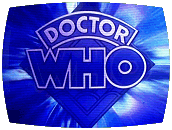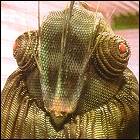 The Doctor and Romana, after an unsuccessful attempt at a Brighton vacation, pay a visit to the war-torn planet Argolis. Laid to waste by a war between the native Argolins and the reptilian Foamasi, Argolis is now not much more than a deadly environment whose sole artificial structure – the Leisure Hive – is a holiday resort with an anti-war theme. The Argolins themselves are sterile, and have been sponsoring tachyon experiments conducted by a human named Hardin. Hardin boasts that he can use tachyonics to reverse the aging process of the Argolins, but in truth he’s nowhere close to that goal. The arrival of two Time Lords seems to coincide with a wave of violence, including a man who appears to have been strangled with the Doctor’s scarf. But the presence of two seasoned time travelers also threatens to unravel a plan to sell the defective tachyon technology to the Argolins…and the Doctor and Romana soon become targets themselves. To make matters worse, the brash young son of the Argolins’ leader has plans to lift his people from a dying, pacifist race to conquerors of the galaxy.
The Doctor and Romana, after an unsuccessful attempt at a Brighton vacation, pay a visit to the war-torn planet Argolis. Laid to waste by a war between the native Argolins and the reptilian Foamasi, Argolis is now not much more than a deadly environment whose sole artificial structure – the Leisure Hive – is a holiday resort with an anti-war theme. The Argolins themselves are sterile, and have been sponsoring tachyon experiments conducted by a human named Hardin. Hardin boasts that he can use tachyonics to reverse the aging process of the Argolins, but in truth he’s nowhere close to that goal. The arrival of two Time Lords seems to coincide with a wave of violence, including a man who appears to have been strangled with the Doctor’s scarf. But the presence of two seasoned time travelers also threatens to unravel a plan to sell the defective tachyon technology to the Argolins…and the Doctor and Romana soon become targets themselves. To make matters worse, the brash young son of the Argolins’ leader has plans to lift his people from a dying, pacifist race to conquerors of the galaxy.
Season 18 Regular Cast: Tom Baker (The Doctor), Lalla Ward (Romana), Matthew Waterhouse (Adric), Sarah Sutton (Nyssa), Janet Fielding (Tegan), John Leeson (voice of K9)
written by David Fisher
directed by Lovett Bickford
music by Peter HowellGuest Cast: Adrienne Corri (Mena), David Haig (Pangol), Laurence Payne (Morix), John Collin (Brock), Nigel Lambert (Hardin), Martin Fisk (Vargos), David Allister (Stimson), Ian Talbot (Klout), Andrew Lane (Chief Foamasi), Roy Montague (Argolin Guide), Harriet Reynolds (Tannoy voice), Clifford Norgate (Generator voice), David Bulbeck, David Korff, James Muir (Foamasi), Alys Dyer (Baby)
Original Title: The Argolins
Broadcast from August 30 through September 20, 1980
LogBook entry & review by Earl Green
Review: The Leisure Hive is John Nathan-Turner’s first outing as the final producer of Doctor Who on British television. Depending on whether or not you enjoyed the decade that JNT spent in the producer’s office, you might then consider Leisure Hive to be the dawn of a new era for Doctor Who, or the beginning of the end. One has to look at the 18th season’s premiere in context, however. Season 17, produced by Graham Williams, started strong with Destiny Of The Daleks and City Of Death, and went downhill from there. Season 17 culminated in the phenomenally silly The Horns Of Nimon, which drowned an intriguing premise with lousy scripts and a cast who seemed to refuse to take the story seriously. After that disappointing conclusion to the previous year, and the cancellation of the 17th season’s final story (Shada), Leisure Hive isn’t a bad season opener. Actually, it’s fairly good no matter how you slice it.
One of my favorite things about JNT’s single season with Tom Baker as the Doctor is that he seemed to be moderately successful in wrenching the show back toward a dramatic tone, as opposed to the humorous feel that pervaded Graham Williams’ stint in the producer’s chair. Tom Baker, when told point-blank to play the role of the Doctor in a dramatic fashion, can do a damned good job of it – and the end of part one is an excellent example, with the cliffhanging moment of the Doctor screaming in agony as he seems to be torn apart inside the tachyon chamber. The “old man” makeup job on Baker after the sudden aging of the Doctor was above average as well.
As for the guest cast…it almost goes without saying that Adrienne Corri’s maginificent performance as Mena overshadows the rest of the visiting actors. She brings dignity to a part that could so easily have been overlooked beneath her bizarre Argolin hair and makeup job. That she shines so brightly in her role – from self-assuredness to being beaten and tired – lends a great deal of credibility to a sometimes hard-to-follow storyline. Nigel Lambert also provides an excellent performance in the role of Hardin, who gradually evolves into a man with a conscience and winds up providing a trump card that saves the day.
 The production values of The Leisure Hive are a huge step up from the previous season, but for a budget increase that was meant to bring Doctor Who into the age of Star Wars, it really only serves the bring the show neck-and-neck with a 1980 TV contemporary – the American-produced Buck Rogers series – in terms of visual effects and the overall look of the production. Still, having said that, there’s something fitting about the corrugated metal millieu of Argolis – it smacks of an artificial, pre-fabricated environment. I actually like the sets in this story quite a bit.
The production values of The Leisure Hive are a huge step up from the previous season, but for a budget increase that was meant to bring Doctor Who into the age of Star Wars, it really only serves the bring the show neck-and-neck with a 1980 TV contemporary – the American-produced Buck Rogers series – in terms of visual effects and the overall look of the production. Still, having said that, there’s something fitting about the corrugated metal millieu of Argolis – it smacks of an artificial, pre-fabricated environment. I actually like the sets in this story quite a bit.
There are moments, however, when the attempts to put all of that money on the screen backfire. How many times do we have to see that damned shuttle landing? Or the incredibly feeble point-the-camera-directly-into-a-studio-light sunrise? Some shaky camera work – very jumpy zooms and such – also detract from some moments meant to be intensely dramatic. Peter Howell‘s underscore – the first musical score created completely in-house at the BBC Radiophonic Workshop since 1972 – is effective in many places, but in a few places it’s just as over-the-top and cheesy as some of the visuals…even when taking the style of the time into account.
But overall, I like Leisure Hive a lot. It sports a dense script, one which demands at least one repeat viewing to pick up all of the clues and put the puzzle together. There are some odds and ends which are never quite explained – such as how one hides a huge honkin’ Foamasi, complete with Barney-like tail, in the guise of a much less bulky human – but the end effect is more than the sum of its parts. And, lest I miss an opportunity to say it again…it was good to see Tom Baker strutting his stuff as a dramatic Doctor instead of a woefully comedic Doctor. The previous few years’ tongue-in-cheek performances had made me forget just how good an actor Mr. Baker is.

